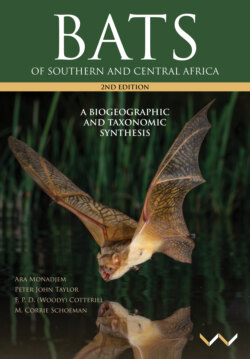Читать книгу Bats of Southern and Central Africa - Ara Monadjem - Страница 33
На сайте Литреса книга снята с продажи.
Sedimentary rocks
ОглавлениеMany formations of sedimentary rocks exercise significant controls over bats in southern Africa today. The oldest formed as long ago as 3.8 billion years. The oldest of these – the rocks of the Dominion Group (over 3 billion years old) – represent the earliest accumulation of sediments on the basement provided by the Kaapvaal Craton, and are preserved in the North West Province of South Africa. In northern KwaZulu-Natal and Eswatini similar formations developed and include the Nsuze Group (3,000 Ma). The slightly younger sedimentary formations of the Transvaal Supergroup (2,600–2,100 Ma) and the extensive Waterberg and Soutpansberg groups (1,800 Ma) formed after renewed rifting and the eventual subsidence of extensive areas to below sea level. Cyanobacteria thrived in this shallow sea and caused the precipitation of a deep layer (up to 1 km deep) of calcium carbonate across most of the Kaapvaal Craton; this calcium carbonate was later converted to dolomite (calcium magnesium carbonate). Today the dolomites form karstic outcrops in the Northern Cape, North West, Gauteng and Mpumalanga in South Africa and in southern Botswana (the Ghaap and Chuniespoort groups). The Transvaal Supergroup also contains thick quartzites, which represent highly recrystallised sandstones.
Later, the hard sandstones in these sediments were weathered and eroded into ridges and mountain ranges, and their regular horizontal bedding led to the formation of crevices. Many species of molossid and vespertilionid bats now exploit these crevices for shelters.
Although deep caves are the exception in these sandstones, caves and sinkholes characterise the surface weathering of the slightly soluble dolomites. The large cave systems that formed in these rocks, for example at the Cradle of Humankind in Gauteng and Gcwihaba (Drotskys') Caves in northwestern Botswana, are significant to several species of bats. The extensive caves in Gauteng, which many of us more readily associate with hominin ancestors, provide critically important roosting resources for the breeding and seasonal roosts of several species, notably the Natal long-fingered bat, Miniopterus natalensis. It is remarkable to realise that ancient marine bacteria formed these Gauteng dolomites between 2,600 and 2,400 Ma.
Precambrian dolomites in central Zimbabwe (the Lomagundi Formation) and in central Zambia and southern Katanga in the DRC are equally important and a high density of cave systems characterises these regions, for example, the Mpongwe and Chipongwe caves in Zambia (Kaiser et al. 1998), and the Chinoyi and Mabura caves in central Zimbabwe. These calcareous formations scattered across the southern Congo basin and northern Zambia are associated with metamorphosed sediments of the Lufilian Arc (∼700 Ma), represented in the heavily mineralised Copperbelt of northern Zambia and neighbouring Katanga (Kaiser et al. 1998, Porada and Berhorst 2000, Wendorff 2005). The caves formed in these calcareous formations across Katanga support a diverse bat fauna (Hayman et al. 1966, Whitaker and Black 1976, Anciaux de Faveaux 1978). In addition, some localised deposits of limestones in banded ironstones, and also the ancient greenstones, have weathered into cave systems, and also constitute important bat roosts; examples that have escaped mining occur in the vicinity of Redcliff in Zimbabwe (F. P. D. Cotterill, unpublished data).
Two important sandstone formations had their origins during Gondwana times. The first is the Cape Supergroup (∼500–460 Ma), which ultimately formed the Cape Fold Belt mountains that fringe Africa’s southern margin. The second important formation was forged during the Mesozoic, in Karoo times, when vast sediments built up across the interior of Gondwana and formed the Karoo Supergroup (∼350–200 Ma). Ultimately, the more recent of these sediments, the Molteno and Ecca formations, came to form extensive sandstone formations in southern Africa, while wind-borne sand deposition resulted in the Cave Sandstones (Clarens Formation), characteristic of parts of the Drakensberg mountains. These Karoo sandstones, especially where exposed along valley margins, provide important roosts to bat assemblages, notably in the Limpopo, Luangwa and Zambezi drainage basins.
